As an Amazon Associate CoffeeXplore.com earns from qualifying purchases.
Master Adaptogen Tea The Essential Guide to Blends and Dosage
Struggling with that constant feeling of being tired but wired? You’re managing daily stress, but it feels like you’re always one step behind, never truly recovering. This isn’t just in your head; it’s a physiological response to a world that never slows down.
You need a solution that works with your body, not against it. Enter adaptogen tea, a type of functional beverage made from non-toxic plants that help your body resist stressors. Many traditional remedies promise relief, but adaptogens work differently, targeting the root cause of your stress response.
Adaptogen tea is a functional, herbal beverage that helps the body resist physical, chemical, and biological stressors by exerting a normalizing effect on bodily processes. In this guide, you’ll discover the science behind how they work, which herbs are best for you, and how to create delicious blends that make daily stress management a ritual you’ll actually enjoy.
The Scientific Secret: Why Adaptogen Tea Is Your Ultimate Stress Solution
Adaptogens are non-toxic plant substances that help the body resist physical, chemical, and biological stressors by exerting a normalizing effect on bodily processes. They primarily work by modulating the Hypothalamic-Pituitary-Adrenal (HPA) axis, helping to regulate the body’s cortisol response and restore stable equilibrium, or homeostasis.
To be classified as an adaptogen, a plant must meet three strict criteria. First, it must be non-toxic and safe for long-term consumption. Second, it must help your body build a non-specific resistance to a wide range of stressors. Finally, and most importantly, it must have a normalizing effect, meaning it helps bring your body’s systems back into balance, or homeostasis.
This is what truly separates adaptogenic beverages from other herbal teas. While chamomile may help you relax, adaptogens go deeper by directly communicating with your HPA axis. This is the command center for your stress response. When you face chronic stress, your HPA axis can become dysregulated, leading to out-of-balance cortisol levels. Adaptogen tea helps modulate this system, preventing your body from entering the state of exhaustion that so many of us experience. This concept has deep roots, originating from Soviet research to enhance endurance and drawing from thousands of years of use in traditional systems like Ayurveda.
The Essential Guide to [9] Powerhouse Adaptogens for Tea Blending
Discovering the right adaptogen is about matching the herb’s specific function to your personal stress symptoms. Whether you need calming support, a clean energy boost, or enhanced immune resilience, there’s an adaptogenic herb that fits your needs. Here’s a deep dive into the properties, flavors, and ideal applications for the top adaptogens perfectly suited for tea.
1. Ashwagandha: The Root for Calming Cortisol

Pin this genius tips to your ‘Stress Management’ board!
Herb Profile & Attributes:
- Primary Function: Anxiety and stress reduction (anxiolytic). Strong support for reducing high cortisol levels.
- Flavor Profile: Distinctly earthy, slightly bitter, and often described as “rooty.” Requires blending for palatability.
- Extraction Method: Requires decoction (simmering) due to its dense root nature, not simple infusion.
- Product Tip: Look for certified organic Ashwagandha root powder or small cut and sifted root pieces to maximize surface area for extraction.
How to Prepare Ashwagandha Decoction:
- Measure 1 teaspoon of dried Ashwagandha root or powder per cup of water.
- Combine the herb and water in a non-reactive saucepan (glass or ceramic).
- Bring the water to a boil, then immediately reduce heat to a low simmer.
- Cover the pot and allow the blend to simmer gently for 15-20 minutes to fully extract the beneficial compounds.
- Strain the decoction through a fine-mesh sieve into your cup, then blend with milk and honey to mask the strong flavor.
Pro-Tip: Combining Ashwagandha with a small amount of healthy fat (like a teaspoon of coconut oil or ghee) may enhance the bioavailability of its active compounds, the withanolides.
2. Holy Basil (Tulsi): The Daily Stress Defense
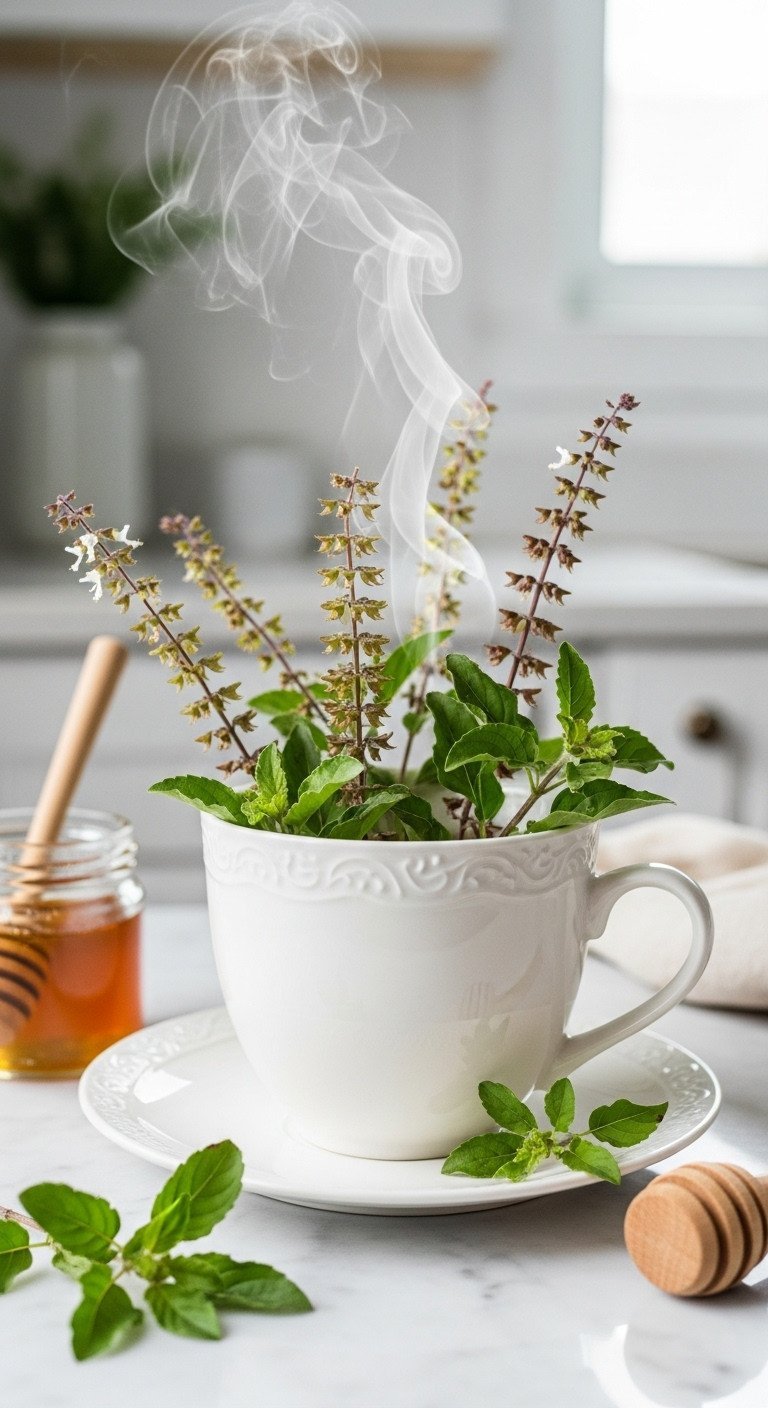
Save this clever organization idea!
Herb Profile & Attributes:
- Primary Function: General stress resilience, immune support, and mild anti-inflammatory effects. Considered a foundational daily adaptogen.
- Flavor Profile: Pungent, spicy, slightly sweet, and aromatic (clove-like notes). Highly palatable as a stand-alone tea.
- Extraction Method: Standard infusion (steeping) is sufficient for the leaves and lighter parts of the plant.
- Product Tip: Opt for a blend containing all three varieties of Tulsi (Rama, Vana, and Krishna) for the most comprehensive benefits.
Simple Daily Tulsi Infusion Steps:
- Bring fresh, filtered water to a boil (212°F).
- Place 1 teaspoon of dried Tulsi leaves (or one tea bag) into your cup or infuser.
- Pour the hot water over the leaves.
- Cover the cup to trap the volatile essential oils and steep for 5-7 minutes.
- Remove the leaves and enjoy, or add a slice of lemon for brightness.
Pro-Tip: Tulsi leaves are known for their high antioxidant activity; avoid re-steeping more than once, as subsequent brews offer minimal functional benefit.
3. Reishi Mushroom: The Immune & Relaxation Booster
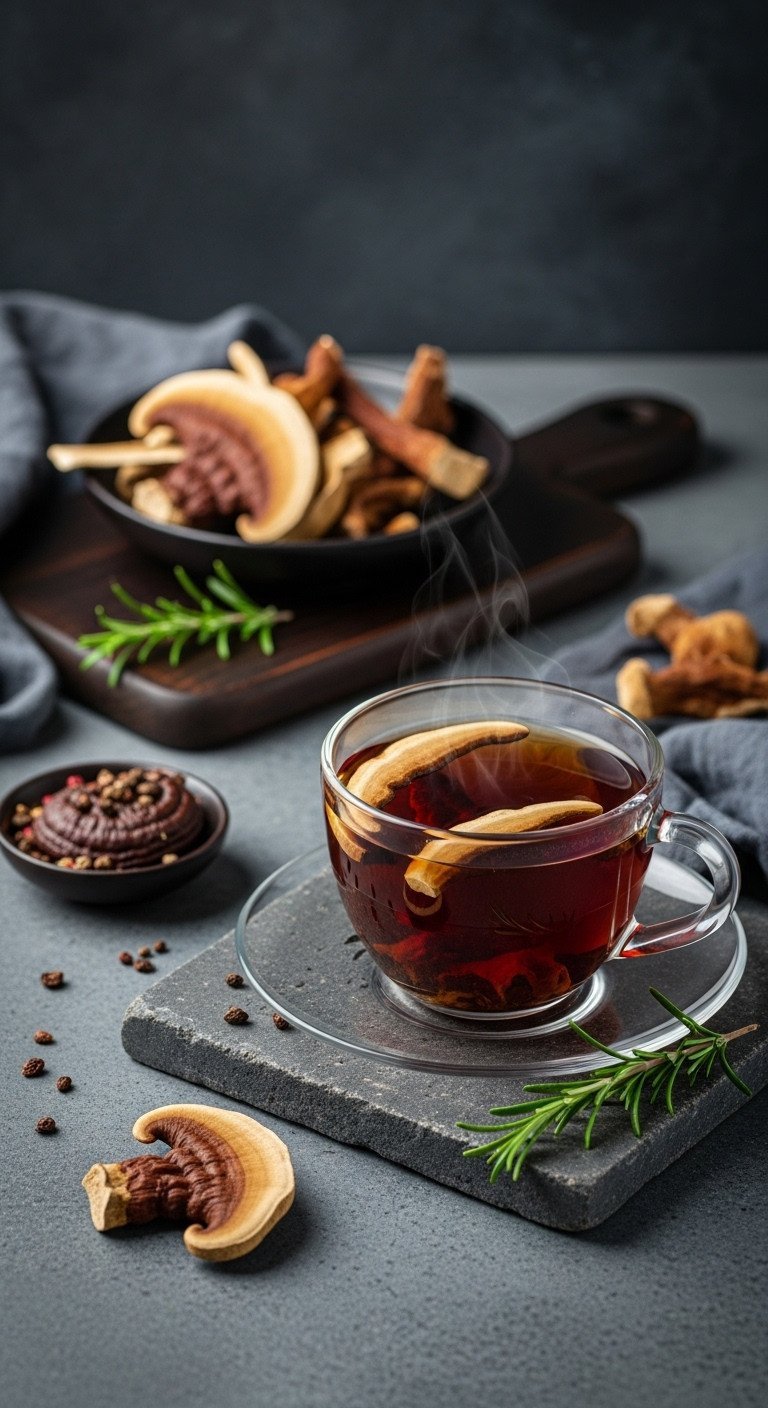
Save this clever immune support blend!
Herb Profile & Attributes:
- Primary Function: Immune system regulation, deep relaxation, and potential liver support. Excellent for calming the mind before sleep.
- Flavor Profile: Distinctly savory, earthy, and often quite bitter due to the triterpenes. Requires masking agents (cacao, honey, milk).
- Extraction Method: Requires a lengthy decoction due to the hard, woody structure to extract polysaccharides and triterpenes.
- Product Tip: Use Reishi mushroom powder for convenience, or dried, sliced pieces if you plan to decoct multiple servings at once.
Maximize Reishi Extraction via Decoction:
- Add 1-2 tablespoons of Reishi slices (or 1 tsp powder) and 3 cups of water to a non-reactive saucepan.
- Bring to a rapid boil, then immediately reduce to a low, consistent simmer.
- Simmer, uncovered, for 30-45 minutes until the liquid reduces by about one-third.
- Strain the liquid into a cup. The bitter taste is a sign of triterpenes, which are highly beneficial.
- CRITICAL STEP: Add strong flavors like black coffee, cocoa, or vanilla milk to make the tea palatable.
Pro-Tip: If using powder, you can skip the long simmer and simply add it to boiling water, but you must mix it vigorously or use a blender to ensure it dissolves fully, especially when using quality fruiting body extracts.
4. Rhodiola Rosea: The Anti-Fatigue and Focus Enhancer
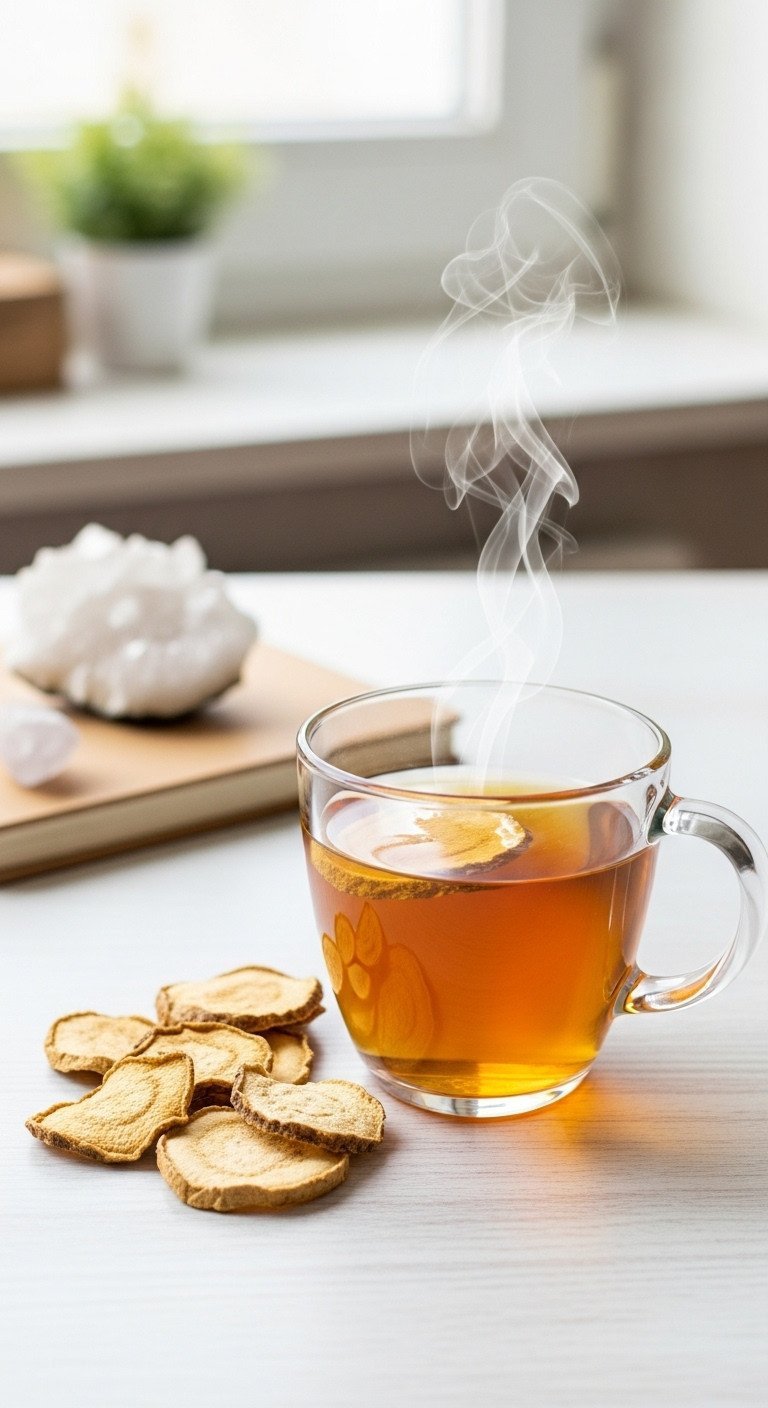
Pin this anti-fatigue tea ritual!
Herb Profile & Attributes:
- Primary Function: Reduces mental and physical fatigue, enhances cognitive function, and improves emotional stability under stress. Acts as a mild stimulant.
- Flavor Profile: Mildly bitter and astringent, sometimes described as floral or rosey. Often blends well with citrus and mint.
- Extraction Method: A shorter decoction (10-15 minutes) or a very long, covered infusion is recommended for the dense root material.
- Product Tip: Seek out Rhodiola Rosea from Siberian or high-altitude sources, which are known to have higher concentrations of active compounds (rosavins and salidrosides).
Optimizing Rhodiola for Energy:
- Use a high-quality stainless steel infuser to hold your Rhodiola root pieces (1/2 teaspoon per cup).
- Bring water to a near-boil (200°F), but avoid a rolling boil to protect heat-sensitive compounds.
- Steep the root for 10-15 minutes, covered, to ensure extraction while preserving volatile elements.
- Add lemon juice or fresh ginger to improve the flavor and complement the mild bitterness.
- Timing Note: Consume only in the morning or early afternoon, as consumption too late can interfere with sleep initiation.
Pro-Tip: Clinical studies often use doses higher than a simple tea infusion provides; for targeted, acute fatigue, consider pairing the tea ritual with a standardized Rhodiola capsule taken earlier in the day.
5. Ginseng (Siberian/Panax): For Endurance and Cognitive Clarity
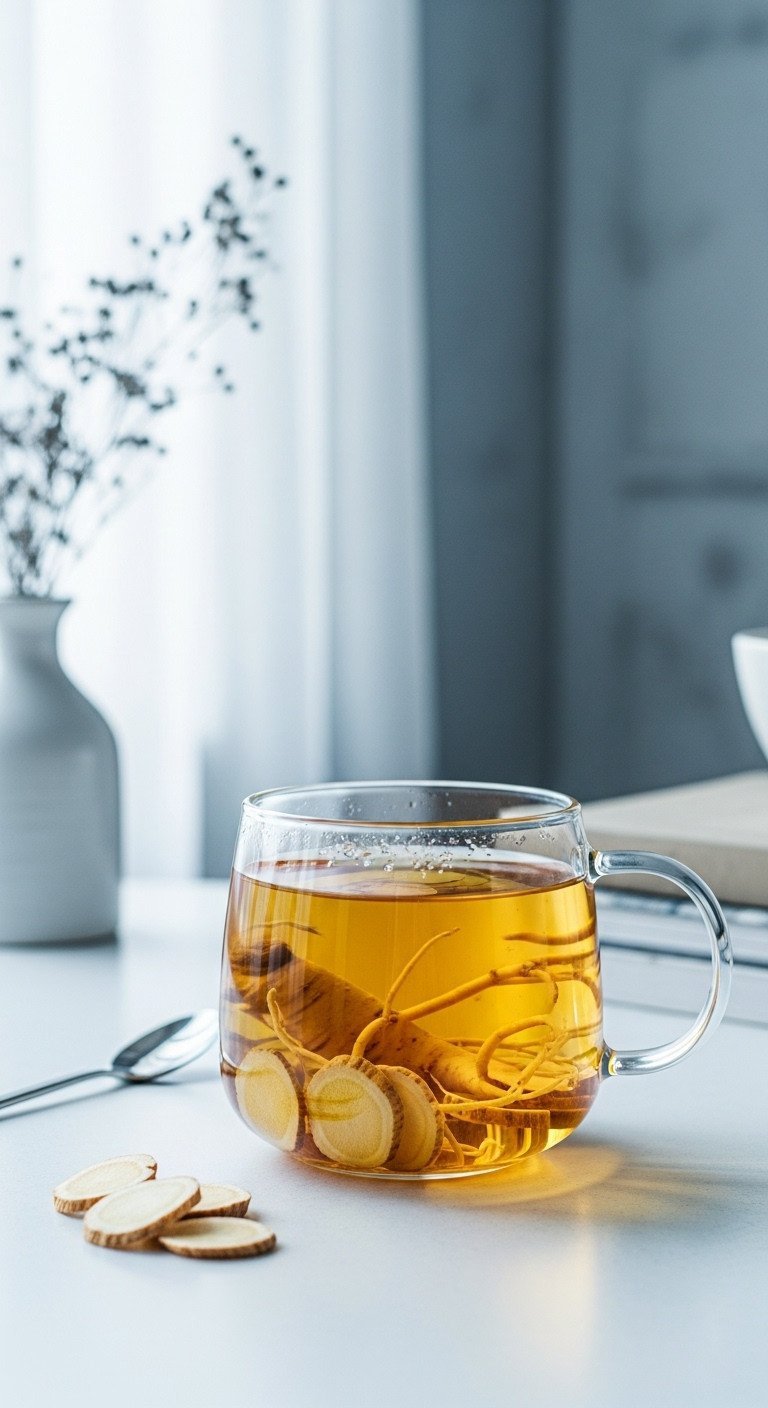
Save this focus booster!
Herb Profile & Attributes:
- Primary Function: Boosts physical stamina, aids recovery from intense activity, and enhances concentration and memory. Very stimulating; avoid late afternoon use.
- Flavor Profile: Earthy, slightly sweet, and mildly bitter. Panax (Asian) Ginseng is generally stronger and more bitter than Siberian Ginseng (Eleuthero).
- Extraction Method: Requires decoction (simmering for at least 15-20 minutes) due to the highly dense, potent root.
- Product Tip: Use only the root pieces or slices; avoid synthetic Ginseng variants. Siberian Ginseng (Eleuthero) is often preferred in tea for its milder side effects compared to Panax.
Brewing Ginseng for Maximum Potency:
- Place 1-2 thin slices of dried Ginseng root or 1 teaspoon of shredded root in a decoction pot.
- Add 2 cups of water and bring to a rolling boil.
- Reduce heat and simmer, covered, for 20 minutes.
- Strain and consume the decoction. The root can often be re-boiled (re-decocted) a second time for a slightly weaker brew.
- Blend with lemon and honey to enhance the flavor, as the bitterness can be intense.
Pro-Tip: Ginseng is highly stimulating. If you are prone to anxiety or high blood pressure, consult a physician before using Ginseng tea and consider using smaller doses or switching to a calming adaptogen like Tulsi.
6. Schisandra Berry: The Five-Flavor Tonic
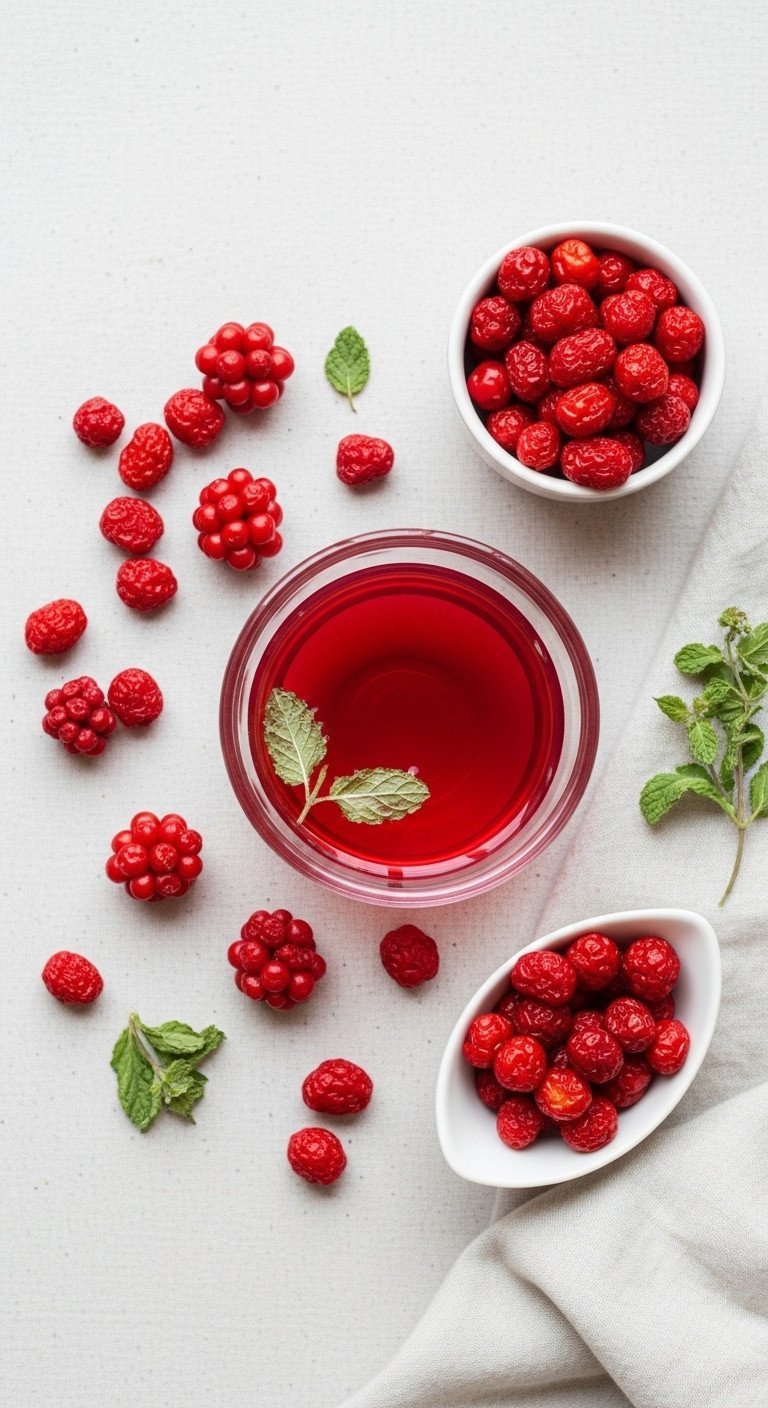
Pin this skin and liver tonic recipe!
Herb Profile & Attributes:
- Primary Function: Supports liver function and detoxification, enhances endurance, and provides antioxidant protection. Used traditionally for skin health and mental function.
- Flavor Profile: Known as the “five-flavor berry” (sour, sweet, salty, pungent, and bitter). Sourness usually dominates the flavor in a tea infusion.
- Extraction Method: Decoction (simmering for 10-15 minutes) or a long cold infusion (12 hours) works well.
- Product Tip: Use dried, whole Schisandra berries and lightly crush them before brewing to release the flavor and beneficial lignans.
Perfecting the Five-Flavor Schisandra Brew:
- Lightly crush 1 teaspoon of dried Schisandra berries (use a mortar and pestle or the back of a spoon).
- Combine berries and 1.5 cups of water in a small saucepan.
- Simmer gently, covered, for 10-15 minutes to soften the fruit and extract the lignans.
- Strain the tea and note the sour flavor. This tea is excellent served warm or cold.
- Blending Tip: Due to its sourness, Schisandra blends perfectly with sweet, calming herbs like Licorice root or complementary flavors like hibiscus.
Pro-Tip: The lignans in Schisandra are fat-soluble. While brewing in water is effective, consuming a small amount of healthy fat (like a spoonful of yogurt) with the tea may help optimize absorption.
7. Blending Principles: Mastering Adaptogen Flavor Synergy
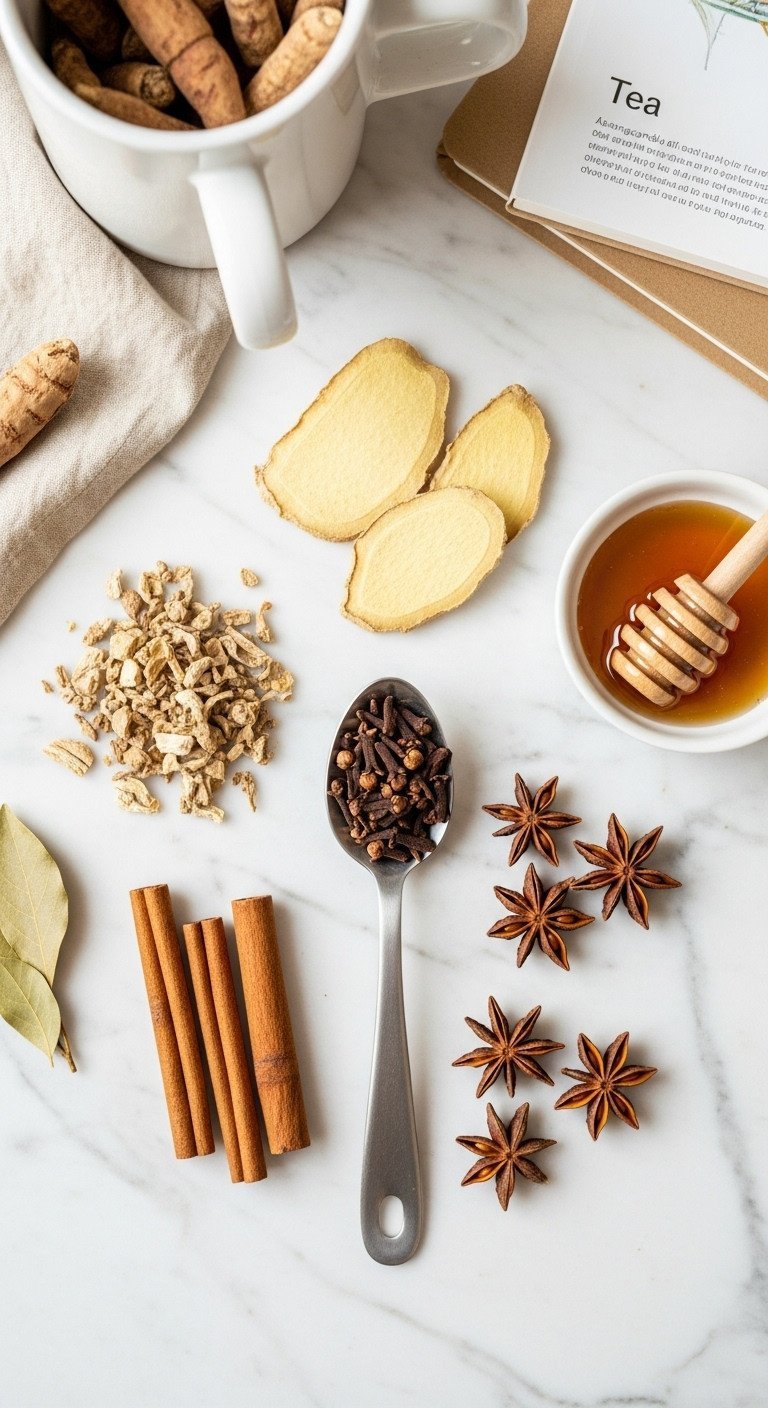
Pin this expert blending chart!
Flavor Agents & Tools Needed:
- Primary Adaptogen: (e.g., Earthy Ashwagandha, Bitter Reishi)
- Sweeteners/Masking Agents: Dried Licorice root (sweet, excellent synergistic adaptogen), Stevia, Maple Syrup, Honey
- Aromatics/Spices: Fresh Ginger, Cinnamon Sticks, Cardamom pods, Star Anise (use to balance earthy notes)
- Tools: Digital kitchen scale (for accuracy), Fine-mesh infuser or tea bag, Non-reactive saucepan.
Three Essential Blending Rules:
- Rule of Palatability: Mask bitter or earthy primary adaptogens (Ashwagandha, Reishi) with 20-30% flavorful aromatics (Cinnamon, Ginger, Licorice) or creamy milk bases.
- Rule of Function: Blend calming adaptogens (Ashwagandha, Tulsi) with supporting nervines (Chamomile, Lavender) for sleep, or blend stimulating adaptogens (Rhodiola, Ginseng) with complementary cognitive aids (Lion’s Mane, Gotu Kola) for focus.
- Rule of Extraction: Always brew the densest ingredient (roots/mushrooms) via decoction first, then add lighter materials (leaves/berries) in the last 5 minutes of steeping to prevent flavor and potency loss.
Pro-Tip: Licorice root is an excellent natural sweetener that also acts as an adaptogen itself by supporting adrenal function and enhancing the bioavailability of other herbs. Use sparingly due to potential blood pressure effects.
8. Expert Recipe: Calming Bedtime Ashwagandha Latte
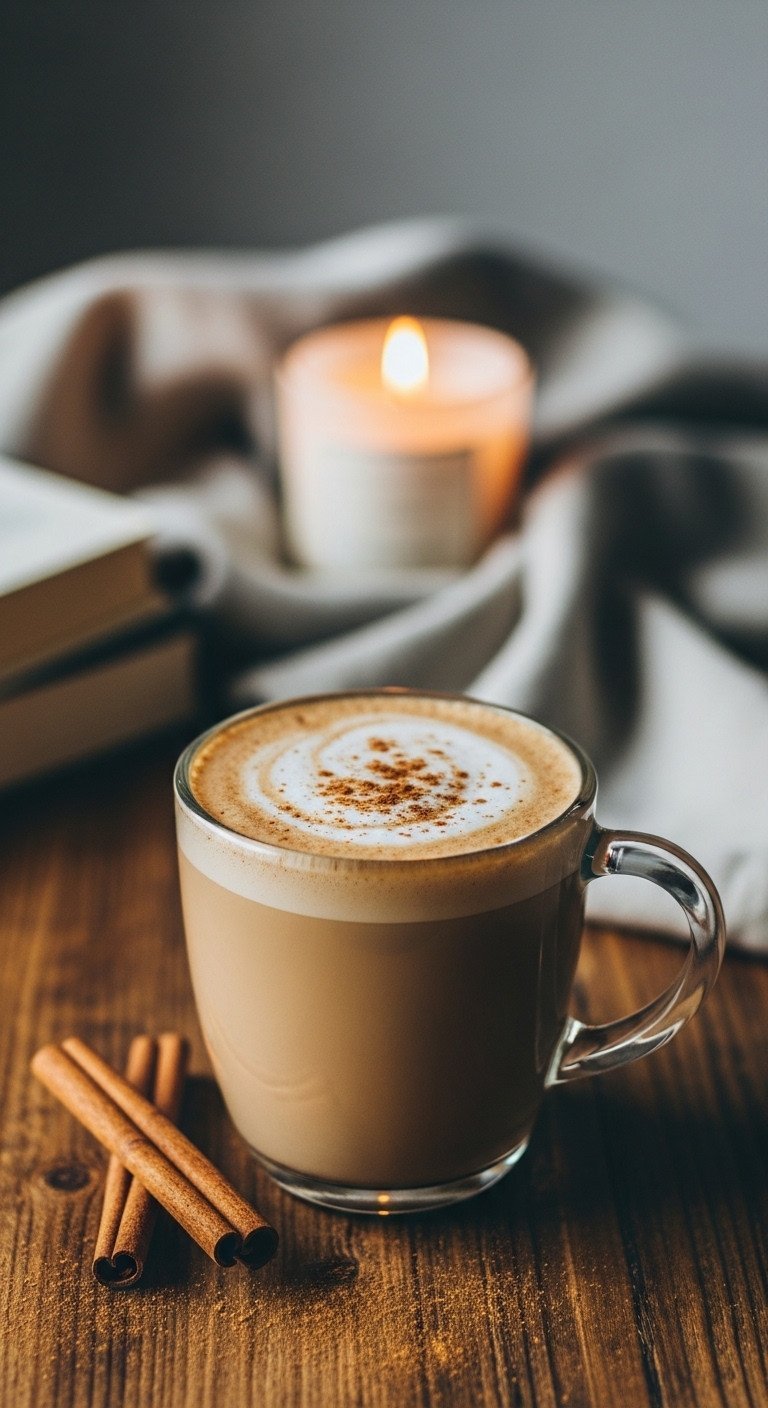
Save this cozy bedtime ritual!
Ingredients & Tools Used:
- 1 tsp high-quality Ashwagandha root powder
- 1 cup filtered water
- 1/2 cup unsweetened Oat Milk (or preferred alternative)
- 1/2 tsp Ceylon Cinnamon (for flavor and blood sugar)
- 1/4 tsp ground Cardamom
- 1 tsp Maple Syrup or Honey
- Small saucepan
- Milk frother (optional, but recommended)
Step-by-Step Calming Latte Directions:
- Decoct the Herb: In a small saucepan, combine water, Ashwagandha powder, Cinnamon, and Cardamom. Bring to a boil, then simmer for 5 minutes.
- Strain & Combine: Strain the spiced decoction into your mug, discarding the solids (if using root pieces).
- Heat the Milk: Gently warm the oat milk in the saucepan. If using a frother, heat the milk separately and froth until light and airy.
- Sweeten: Stir the Maple Syrup or Honey into the brewed tea base.
- Assemble: Pour the frothed or warm milk over the tea base. Dust with an extra pinch of cinnamon for aroma and presentation.
- Enjoy: Sip slowly 60-90 minutes before your desired bedtime.
Pro-Tip: Using an electric milk frother greatly improves the texture and palatability of adaptogen drinks, as the creaminess helps mask the earthy notes.
9. Expert Recipe: Energizing Rhodiola & Ginger Iced Tea

Pin this instant summer energy tips!
Ingredients & Tools Used:
- 1 tsp dried Rhodiola root slices
- 2-3 slices fresh Ginger root
- 3 cups filtered water
- Juice of 1/2 Lemon (enhances flavor)
- 1-2 tbsp Maple Syrup or Stevia drops
- Large glass pitcher
- Fine-mesh strainer
Step-by-Step Iced Tea Preparation:
- Prepare Decoction Base: Combine Rhodiola, Ginger, and water in a saucepan. Bring to a boil, then simmer gently, covered, for 15 minutes.
- Cool Completely: Strain the concentrated decoction into a heat-safe pitcher, discarding the solids. Allow the tea to cool completely to room temperature (about 1 hour).
- Flavor Integration: Stir in the lemon juice and your preferred sweetener. Taste and adjust for tartness and sweetness.
- Chill: Refrigerate the tea for at least 2 hours to fully chill.
- Serve: Serve over a generous amount of ice. Garnish with fresh lemon slices and mint leaves for aesthetic appeal and extra freshness.
Pro-Tip: If using this blend consistently, make a double batch of the concentrated decoction on Sunday and store it in the refrigerator for quick daily servings throughout the week.
Dosage, Safety, and Long-Term Success Protocol
For noticeable systemic modulation of stress, adaptogen tea requires consistent daily consumption over 2 to 4 weeks. Herbalists recommend cyclical dosing (e.g., 5 days on, 2 days off) to maintain sensitivity and long-term efficacy.
Unlike a painkiller, adaptogens don’t offer immediate, acute relief. Their power lies in their cumulative effect on your body’s systems. You must commit to a daily ritual for at least a few weeks to allow the phytochemical compounds to build up and begin modulating your HPA axis. Tracking your perceived stress, sleep quality, and energy levels during this period is the best way to measure your progress.
To ensure long-term success and prevent your body from building a tolerance, herbalists often recommend a cyclical dosing protocol. This could mean taking the tea for five consecutive days and then taking a two-day break each week, or consuming it daily for four weeks followed by a full week off.
Finally, safety is paramount. While adaptogens are defined as non-toxic, they are potent botanical substances. It is crucial to consult with a licensed healthcare professional before incorporating adaptogen tea into your routine, especially if you are pregnant, nursing, taking prescription medication, or have a pre-existing condition like an autoimmune disorder or high blood pressure.
Key Takeaways: Your Quick Guide to Adaptogen Mastery
- The Science: Adaptogens work by modulating your HPA axis and stabilizing cortisol levels, aiming for homeostasis.
- The Timing: Use stimulating adaptogens (Rhodiola, Ginseng) only in the morning/early afternoon, and calming ones (Ashwagandha, Tulsi) in the evening.
- The Brewing Method: Denser herbs (roots/mushrooms) require long decoction (simmering for 20+ min); leaves/flowers use standard infusion (steeping 5-7 min).
- The Flavor Solution: Blend earthy/bitter adaptogens with strong aromatics like ginger, cinnamon, and licorice, or creamy milk bases.
- The Protocol: Commit to 2-4 weeks of consistent daily consumption and follow a cyclical dosing schedule (e.g., 4 weeks on, 1 week off) to maintain sensitivity.
People Also Ask About Adaptogen Tea Safety and Efficacy
How long does it actually take for adaptogen tea to work?
While mild effects like initial relaxation may be noticed quickly, systemic physiological benefits and noticeable modulation of the HPA axis require consistent daily consumption over 2 to 4 weeks to see significant, cumulative results. Tracking sleep quality and perceived stress levels in the first month is the best way to objectively measure efficacy.
Are there any specific contraindications or medications that interact with adaptogen tea?
Yes, contraindications exist, especially with potent adaptogens. Ashwagandha, for example, is often cautioned against in individuals with autoimmune disorders due to its immune-modulating properties. Ginseng should be avoided by those with high blood pressure or anxiety disorders. Always consult a licensed healthcare professional before consuming adaptogens if you are pregnant, nursing, or taking prescription medication.
Is adaptogen tea effective, or is it mostly a placebo effect?
Adaptogens have substantial traditional use and growing scientific evidence, particularly in regulating the HPA axis and reducing measurable biomarkers of stress like cortisol. While the brewing ritual itself offers psychological benefits, the efficacy stems from verified phytochemical compounds like withanolides (Ashwagandha) and rosavins (Rhodiola) that create a non-specific protective response in the body, which is a measurable physiological effect.
What is the main difference between adaptogen tea and high-dose adaptogen capsules?
Tea offers a lower, more sustainable daily dose and reinforces the beneficial stress-reducing ritual of brewing and consumption. Capsules provide a standardized, concentrated dose needed for clinical levels of intervention or acute needs. Tea is generally preferred for long-term maintenance and general stress management.
Final Thoughts: Embracing Balance in 2025
Adaptogen tea is more than a trendy beverage; it’s a commitment to supporting your body’s natural ability to achieve homeostasis in the face of modern stress. By understanding the science of the HPA axis and utilizing simple blending techniques, you can master your dosage and create powerful, delicious daily rituals that promote balance throughout 2025.
Which adaptogen—calming Ashwagandha or energizing Rhodiola—best suits your current stress management goals? Share your go-to tea blend in the comments below
Last update on 2025-12-06 / Affiliate links / Images from Amazon Product Advertising API

